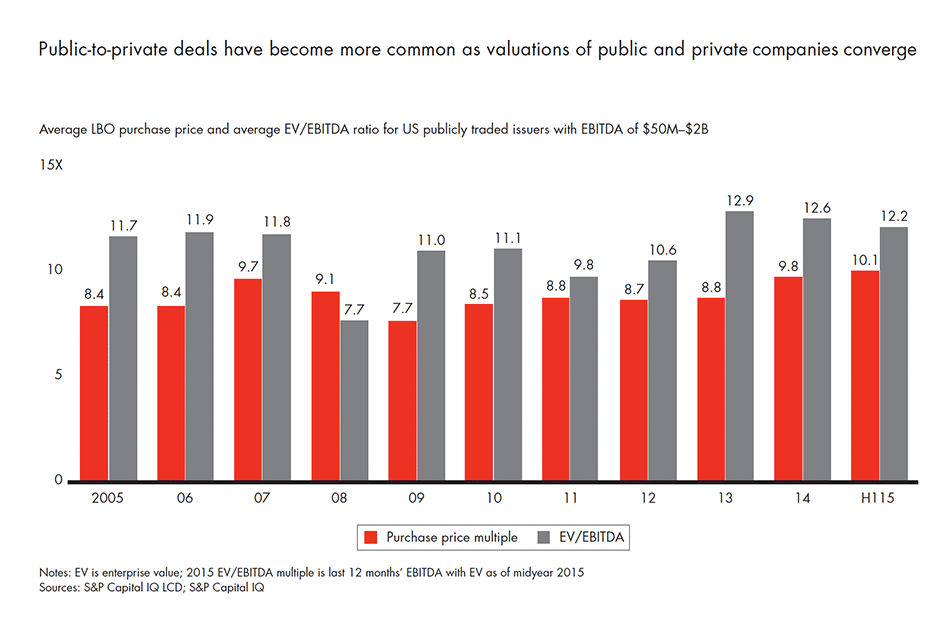Forbes.com
This article originally appeared on Forbes.com.
The map of last year’s investments shows PE firms venturing in many directions to put record amounts of dry powder to work as they maneuvered around the obstacles of ferocious competition fueled in part by a huge wave of corporate mergers and acquisition, high purchase multiples and skittish lenders. As we report in our newly released Bain & Company’s Global Private Equity Report 2016, PE deal making in 2015 was an eclectic mix reflecting the whims of opportunity and timing. Four distinct themes emerged that capture the year’s unique combination of competitive pressures as GPs sought to find ways to deploy a record $1.31 trillion in uninvested dry powder they are sitting on.
Buy-and-build strategies gain in popularity. Under pressure to make high-stakes decisions about whether or not to ante up steep acquisition multiples for assets sold through intensely competitive auctions, more and more GPs are looking into buying businesses they know well—similar to companies already in their portfolios. PE firms have long resorted to buy-and-build strategies, using established portfolio companies as platforms to accelerate growth. Adding bolt-on acquisitions gives PE owners a lot of flexibility to steer their platform portfolio companies in promising new directions, enabling them to grow their core businesses or opening doors to new adjacencies.
Buy-and-build is especially well suited to today’s PE environment, and the numbers from 2015 reflect this. Globally, the value of add-on acquisitions by PE-backed companies more than doubled to a record $267 billion in 2015, nearly matching for the first time the $282 billion invested in all buyouts during the year. By adding on enterprises in the same or related business to a portfolio holding, GPs can target companies that often are too small to attract the attention of big corporate acquirers and can be bought at reduced prices. Particularly as economies slow, owners of smaller companies will be increasingly motivated to sell at lower prices. Indeed, by bolting on several low-cost businesses, GPs can lower the multiples of their initial platform companies while enhancing their growth prospects. Buy-and-builds also give PE funds more options when it comes time to exit, enabling GPs to sell their holdings in part or in their entirety as exit channel conditions dictate.
Public-to-private deals make a comeback. Competitive intensity and deal prices for private companies heated up in 2015 as the public equity markets cooled, causing PE firms to view publicly held companies as attractive investment targets again. Examining a subset of deals where transaction details were available, Bain found that public-to-private conversions accounted for nearly 60% of the value of U.S. buyouts. That large sum put into take-private transactions was spread over relatively few deals—just 14 companies, or little less than 5% of all tracked U.S. buyouts for the period.
The logic behind GPs’ stepped-up interest in taking pricey public companies private can be explained by the tightening convergence of average LBO multiples and the average enterprise value to EBITDA for U.S. publicly traded companies. As the mean LBO multiple edged up to 10.1 times EBITDA in late 2015 from 9.8 times EBITDA a year earlier, the average multiple for public companies fell from 12.6 in 2014 to 12.2 last year.

Finding bargains in the middle market. As every successful angler knows, the surest way to bag a good catch is to fish where others are not. GPs are taking that wisdom to heart by targeting acquisitions in the less crowded waters of small and mid-sized companies. Even larger PE firms are stalking opportunities among smaller enterprises valued at $250 million or less.
At the lower end of the middle market, GPs like the relative bargains that are available, because their small size puts them off the radar of corporate acquirers. Acquiring these lower-cost assets also affords GPs opportunities to pursue buy-and-build strategies, enabling them to assemble several low-multiple companies into a larger entity that can command a far higher multiple upon exiting. For companies valued at less than $250 million, the median multiple, measured as the ratio of enterprise to EBITDA on LBOs, was about half that of companies valued at more than $250 million. As these lower multiples are likely to persist, look for PE funds to continue fishing in middle-market waters in 2016.
Teaming up with strategic buyers to mitigate risk. Recognizing the futility of winning bidding wars against deep-pocketed strategic acquirers caught up in the frenzy of the corporate M&A boom, many GPs have adopted the mantra “If you can’t beat ‘em, join ‘em.” They are finding ways to partner with big companies in buyouts that suit the needs of both. For PE funds, having a strategic coinvestor provides a built-in exit strategy, enabling them to sell their stakes to the corporate partner when the timing is right. Corporations also find much to like about joining forces with buyout funds. Some are tapping their PE partners for capital to share the risk of acquiring new assets they are not yet ready to integrate into their balance sheets and for expertise to help boost performance.
Creative approaches like these will become more common and evolve in the quicker-paced, high-stakes deal-making environment that lies ahead. To succeed, PE firms will need to be nimble in their ability to size up opportunities and be prepared to seize upon novel ways to put capital to work.
Hugh MacArthur, Graham Elton, Dan Haas and Suvir Varma are leaders of Bain & Company’s Private Equity Group.
Carl Evander is a principal in Bain’s Private Equity Group.
